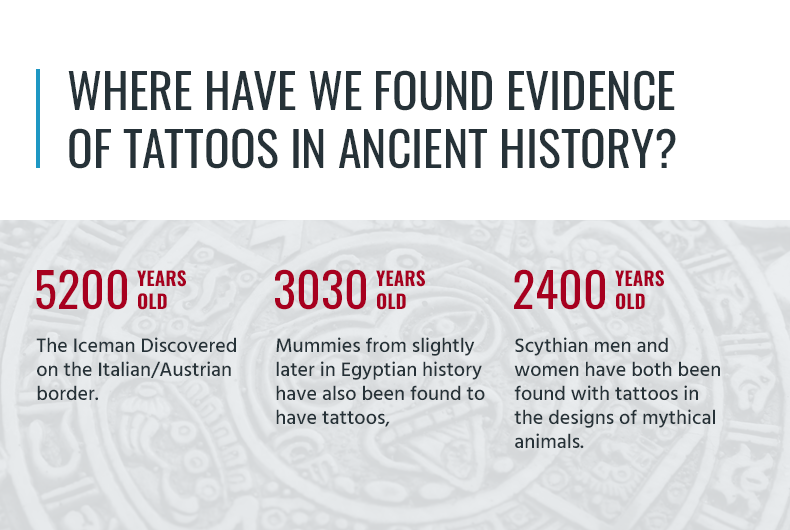
A Brief Look at the History of Tattoos
Do you love tattoos? Are you constantly planning the next design you want to get inked? Then you might want to learn a little bit more about the history of this time-honored tradition.
Of course, the very phrase “history of tattoos” might be confusing. After all, we tend to think of tattoos as something that we have invented in the modern era. It can be difficult to imagine our long-distant ancestors also enjoying getting their favorite designs inked onto their bodies.
But, believe it or not, tattoos are an important part of our global history. From ancient times straight up through our modern era, people have been tattooing themselves. Sometimes it would be part of a religious tradition, other times it would be a meaningful cultural expression, and other times it would be purely for fun or aesthetic value.
Today, in honor of the ancient and well-loved tradition that is tattooing, we’re going to spend some time looking at how tattoos have changed through history, as well as the various important roles they have played across the ages and around the world.
Where Have We Found Evidence of Tattoos in Ancient History?
It’s impossible to say how far back the history of tattoos reaches, as it very likely predates recorded history or archaeological remains. New discoveries are being made every year that add to our picture of ancient tattooing practices. Currently, however, the earliest evidence of ancient tattoos is on the human remains known as the Iceman. Discovered on the Italian/Austrian border, the Iceman is estimated to be approximately 5,200 years old.
Ancient Egyptian mummies provide another example of some of the earliest-known tattoos. Two mummies, one male, and one female, date from somewhere between 3932 and 3030 B.C. The male mummy’s tattoos appear to be an image of a bull or similar animal, while the females are in the shape of multiple S’s. Other female mummies from slightly later in Egyptian history have also been found to have tattoos, suggesting that perhaps tattooing was a largely female practice. Additionally, many figurines and other forms of artwork from the same period seem to depict women with tattoos. Bronze implements identified as primitive tattooing tools were discovered in northern Egypt, seemingly indicating that tattooing was actively practiced across ancient Egypt.
The Nubian culture, south of Egypt, also practiced the art of tattooing in ancient times. Their tattoos were blue and sometimes done in a similar pattern of dots as the Egyptian mummies. Egypt also depicted Libya, an African country to their west, in their artwork. This art portrays one of Libya’s leaders as having clear and geometric tattoos prominently displayed on his body.
Another ancient culture that employed primitive tattoos was the Scythian Pazryk, native to the Altai Mountains of central Asia. Scythian men and women have both been found with tattoos in the designs of mythical animals. These tattoos were not limited to one location on the body and were inked on the limbs, torsos, shoulders, and hands alike, and are roughly 2,400 years old.

According to historical accounts, the ancient Britons also tattooed themselves, likely marking individuals of high-status.
Mummies found in China dating back roughly 4,000 years show evidence of tattooing that appears to have been done in the same style as those found in central Asia. Japanese men practiced tattooing as well, although it appears this either didn’t develop or didn’t become widely adopted until much later.
Tattoos also developed independently across the Atlantic Ocean. The ancient pre-Columbian cultures that existed in modern-day Chile and Peru also appeared to practice tattooing, as mummified remains have been found covered in stylized tattoos of animals and other symbols.
Native North American cultures also present evidence of tattooing, both on the body and face. This is not only limited to cultures on the continent but also includes cultures across modern-day Greenland and the islands off the coast of Alaska.
The tattoos of ancient Polynesia were often extraordinarily elaborate and followed complex designs that could cover the entire body. This practice is believed to have developed slowly over entire millennia.
What Were Ancient Tattoos Made out Of?
Because tattooing practices developed differently in different cultures, there were many different ways of creating a tattoo in the ancient world. It’s unclear what tools were used to create the Iceman’s tattoos, although most experts are confident that the ink was made of soot. While different tools may have been used at different locations and different points throughout history, historians are fairly confident that the ancient Egyptian tattoos were done using a tool that featured a sharp point attached to a wooden handle. Other tools most likely used include a set of bronze instruments that were a bit like flat, wide needles.
In Samoa and other Polynesian cultures, tattoos were traditionally made by tapping a needle into the skin with a mallet. The process was often laborious and painful, and the risk of potentially lethal infection following the procedure was high.
To achieve the actual pigmentation of the skin, dark substances such as soot were often used in certain cultures. It’s highly possible that other cultures around the world used brighter colors, however. Inuit cultures, for example, are thought to have used the color yellow in their tattooing practices.
The Cultural Importance of Ancient Tattoos
It can be difficult to determine the precise importance of tattoos in history, especially in some of the very earliest examples. However, in many cultures and locations around the world, we can determine that tattoos did indeed play an important role and had a great cultural significance.
Interestingly, the tattoos discovered on the Iceman’s body may have been therapeutic. The series of dots and small crosses located on the spine and other various joints appear to have been strategically placed to alleviate joint pain. It’s unclear whether ancient people believed these tattoos had a real physiological effect or if they were more of a spiritual or psychological talisman.
The tattoos in Egypt seem to have been almost exclusively limited to females, leading to multiple theories about their intended purpose. Some suggest they mark prostitutes or dancing girls. However, at least one of the women bearing tattoos was an important priestess, seemingly negating this theory. Another possible explanation for the highly-female nature of tattoos is that they were essentially talismans designed to provide spiritual protection during pregnancy and childbirth.
This theme extends throughout multiple cultures. Some of the tattoo evidence from pre-Columbian South America also seems to be related to fertility and pregnancy. One woman from such a culture bears permanent marks wrapping around her lower torso, across her abdomen, and extending down between her hips in a way that seems likely to be associated with birth somehow.
In other cultures, tattoos were used to mark individuals as belonging to a specific group of people. Ancient Greeks and Romans often used tattooing to mark someone as either a criminal or part of a specific religious order or cult. Herodotus, an ancient Greek historian, asserted that the Scythian tattoos were marks of nobility.
However, it is not only possible but entirely plausible that in many cultures and time periods — just like today — these tattoos were a simple fashion statement. People may have simply liked the way a particular design looked and wanted to imprint it on their bodies.
How Tattooing Has Changed Throughout History
Tattooing was a common practice in Rome, until the widespread acceptance of Christianity. Once this was the dominant religion in Europe, Emperor Constantine banned tattooing. People thought the body was made in the image of God and tattoos would disfigure this sacred vessel. This notion took hold and prevailed for many centuries.
Christian missionaries and colonizers carried this idea with them as they explored the rest of the world. Often, when they would encounter other cultures, missionaries would attempt to discourage these new people from tattooing themselves, with varying degrees of success.
In Egypt, ancient tattooing methods were abandoned and more sophisticated ones were developed. In the 19th century, Egyptian tattoos were created by pricking the skin with several needles and then rubbing a mixture of smoke and milk into the site of the prick. This process was usually practiced on young girls and performed by the older women of the community.
In the Maori culture of New Zealand, tattooing processes evolved as a consequence of European visitors. These Maori tattoos were often highly elaborate and ritualistic in nature. The pigments were made of entirely natural substances, until the arrival of the Europeans, at which point the Maori began adding gunpowder to the pigments.
Despite Christian missionaries’ best efforts to paint tattooing as an unholy practice, however, its popularity began to spread. Sailors and explorers often encountered tattoos on their travels and would return with tattoos of their own. While this led to tattoos being initially seen as a practice mostly carried out by pirates, sailors, and soldiers, tattoos continued to spread. By the 20th century, many other people throughout the West where beginning to get tattoos of their own. In fact, the 1940s are remembered as the golden age of tattooing in Western culture.
In these ways, tattooing is like any other process. It developed within many societies and evolved with them — sometimes organically, and sometimes through collision with another culture. The practice grew, changed and took on new meanings.
It should come as no surprise that tattooing practices have changed immensely since their origins in ancient cultures.
Whereas humans once used wooden and bronze tools to create the designs, we now use finely-crafted needles. Where soot and other substances created the various pigments, we now use specialized inks. Our modern tattoos are designed to last longer, stand out more sharply and be less painful as well.
Safety practices have also significantly improved. We know more about sterilizing tools and completing the tattooing procedure in controlled, sterile environments. We also know to use inks that only use ingredients deemed safe to inject into the skin. We know how to control the risk of infection. Modern tattooing processes are far from perfect and infection is still possible, but practices have improved significantly from their humble beginnings.
In our modern era, you can remove tattoos, a technology and ability that would have been unheard of to the ancient Egyptians, Scythians or Romans. If you decide you no longer want a design inked on your body, you can go to a medical aesthetician or tattoo removal specialist and pay to have it removed. In this way, tattoos are no longer the 100 percent permanent decision that they were for centuries.
Cultural attitudes towards tattoos have shifted, as well. In ancient times, people used tattoos for a variety of purposes. With the rise of Christianity, many cultures began to frown on tattoos and view them as unholy and sacrilegious. Today, attitudes are shifting back more in the direction of our ancient ancestors.
This isn’t to say that today we believe in inking our bodies to ask the gods for a safe and healthy pregnancy. But many cultures are again becoming more accepting of tattoos. They are less of a taboo than they were for centuries in a Judeo-Christian dominated western world.
However, while much of the culture and methodology surrounding tattoos has changed drastically over the years, many things have, surprisingly, stayed the same.
For example, why do people get tattoos today? Many of us would say that we choose to get them because we simply liked a design, thought it was aesthetically pleasing and wanted it immortalized on our bodies. The evidence shows that it was very likely that our ancient ancestors did the same thing.
As for the way many ancient cultures used tattoos to mark themselves as a member of a religious organization, this also applies to our modern world. No, we don’t make it a requirement, and no major religion demands that you tattoo yourself to officially become part of the group. But many individuals choose to get tattoos to express their faith. Many Christians tattoo symbols or quotations of faith on their bodies. Other religions do the same, while others still disapprove of this practice.
Tattooing as an Experience That Transcends Generations
If you already have a tattoo or are thinking of getting one, you may consider it a very isolated experience, limited only to you and other 21st-century individuals. Maybe the thought even crossed your mind that you were taking part in very modern practice.
Clearly, this is not the case. Tattooing existed for thousands of years before any of us were born and it will doubtlessly continue to exist for thousands of years after we’re gone. In this way, we can see that when we choose to tattoo ourselves, we are taking part in an exclusively human form of art that has spanned countless generations. Your tattoos make you part of a chain of ancestors who have been passionately creating artwork on their bodies for millennia.
Looking to Get Your Tattoo Removed?
You can have a great experience getting a tattoo and participating in an art form with such a rich and colorful history, but maybe you’ve decided you want your tattoo removed. Perhaps you’ve outgrown it, or it was a mistake in the first place, or you just no longer like the design. Whatever your reasons for wanting your tattoo removed, modern technology makes it possible.
If you’re looking to get your tattoo removed, come visit us here at MEDermis Laser Clinics. We have locations in both Austin and San Antonio so that you can visit whichever is closest to you. If you’re serious about getting your skin back, there’s no need to wait. Contact us today to schedule your free consultation so that you can learn more about the process and what to expect.

